
USS Newman K. Perry (DD-883/DDR-883), was a Gearing-class destroyer of the United States Navy.

USS Stickell (DD-888) was a Gearing-class destroyer of the United States Navy. She was named for Lieutenant John H. Stickell USNR (1914–1943), who was killed in action at Jaluit Atoll in the Marshall Islands on 13 December 1943 and posthumously awarded the Navy Cross. She was renamed HS Kanaris (D212) on transfer to the Hellenic Navy in 1972.

USS Noxubee (AOG-56) was a Patapsco-class gasoline tanker acquired by the U.S. Navy for the task of transporting gasoline to warships in the fleet, and to remote Navy stations. She served in a commissioned status from 1945 to 1959, and 1965–1975. She was named for a river in Mississippi.

USS Luzerne County (LST-902) was an LST-542-class tank landing ship built for the United States Navy during World War II. Named after Luzerne County, Pennsylvania, she was the only U.S. Naval vessel to bear the name.
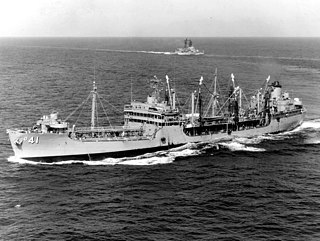
USS Mattaponi (AO-41) was a Kennebec-class oiler which served in the United States Navy during World War II, periodically during the 1950s, and in the Vietnam War. She was the only U.S. Navy ship named for the Mattaponi River in eastern Virginia.
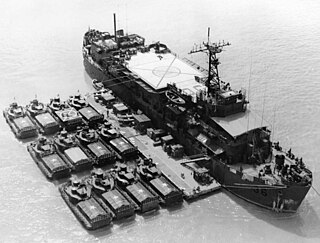
USS Colleton (APB-36), was a Benewah-class barracks ship. Colleton's keel was laid on 9 June 1945, launched on 30 July 1945 and delivered on 27 September 1946. She was berthed at Boston, Massachusetts in the custody of the United States Maritime Commission.
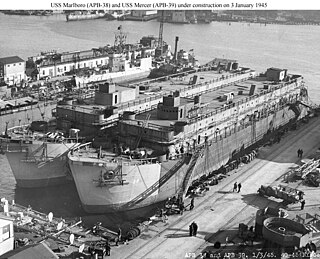
The second USS Mercer is an APL-35-class Barracks ship of the United States Navy. Originally classified as Barracks Craft APL 39, the ship was reclassified as Self-Propelled Barracks Ship APB 39 on 7 August 1944. Laid down on 24 August 1944 by Boston Navy Yard, and launched on 17 November 1944 as APB 39, sponsored by Mrs. Lillian Gaudette, the ship was named Mercer, after counties in eight states, on 14 March 1945, and commissioned on 19 September 1945, Lt. Comdr. Edward E. Vezey, Jr., USNR, in command.

USS Savage (DE-386) was an Edsall-class destroyer escort built for the United States Navy during World War II.

USS Blanco County (LST-344) was an LST-1-class tank landing ship built for the United States Navy during World War II. Named for Blanco County, Texas, she was the only U.S. Naval vessel to bear the name.

USS Sphinx (ARL-24) was laid down as a United States Navy LST-542-class tank landing ship but converted to one of 39 Achelous-class repair ships that were used for repairing landing craft during World War II. Named for the Sphinx, she was the only US Naval vessel to bear the name.
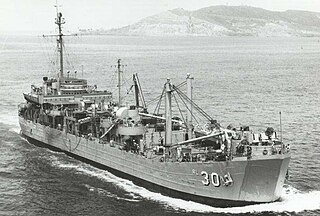
USS Askari (ARL-30) was one of 39 Achelous-class landing craft repair ships built for the United States Navy during World War II. Askari is an Arabic word for soldier, a term frequently applied to indigenous troops in Africa serving European colonial powers, particularly the British and Germans in East Africa from the late 19th century to the end of World War I; ARL-30 has been the only U.S. naval vessel to bear the name.

USS Towhee (AM-388) was an Auk-class minesweeper acquired by the United States Navy for the dangerous task of removing mines from minefields laid in the water to prevent ships from passing.

USS Washtenaw County (LST-1166) was a Terrebonne Parish-class tank landing ship in commission in the United States Navy from 1953 to 1973. Named for Washtenaw County, Michigan, she was the only U.S. Navy vessel to bear the name. It is currently derelict. In October 2008, it was reported to be at the southeastern tip of Lord Island on the Columbia River in Rainier, Oregon at 46°07′18″ N 123°00′51″ W next to the Oregon shoreline. It is listed as a derelict vessel by the interagency Derelict Vessel Task Force, and has suffered damage from vandalism and looting between 2005 and 2008. While some had hoped to restore the ship as a museum ship, there is no funding or plan to do so.

USS Delta (AK-29/AR-9) was the lead ship of her class of repair ships in the United States Navy during World War II. She was originally built as the merchant ship SS Hawaiian Packer before her requisition by the U.S. Navy in 1941. Before conversion to a repair ships, Delta briefly served as a U.S. Navy cargo ship.

USS Madera County (LST-905) was a LST-542-class tank landing ship built for the United States Navy during World War II. Named after Madera County, California, she was the only U.S. Naval vessel to bear the name.

USS Loeser was a Buckley-class destroyer escort of the United States Navy, named in honor of Lieutenant Commander Arthur E. Loeser (1903–1942).

USS Tutuila (ARG-4) was a Luzon-class internal combustion engine repair ship that saw service in the United States Navy during World War II, The Korean War, and The Vietnam War as well as several smaller actions. Named for the Island of Tutuila, the largest and main island of American Samoa, it was the second US Naval vessel to bear the name. After serving for nearly 30 years Tutuila was sold to the Republic of China in 1972.

USS Blackford (APB-45) was a Benewah-class self-propelled barracks ship that was in service with the United States Navy during the waning days of World War II. She was decommissioned in April 1947 and sold for merchant service. In c. 1968-1970, she was sunk as a target by the South African Military.

This article incorporates text from the public domain Dictionary of American Naval Fighting Ships.
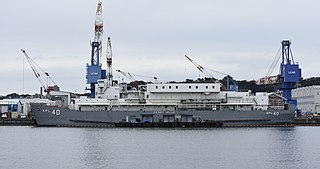
USS Nueces (APB-40) is a Benewah-class barracks ship of the United States Navy. She was notable for her service in the Vietnam War.






















